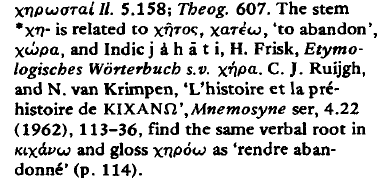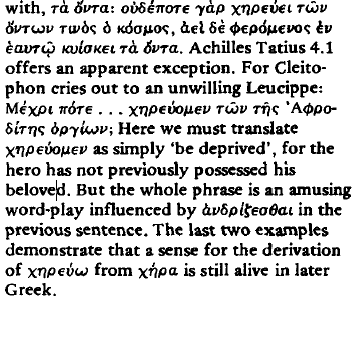Article contents
Goat Island: Od. 9.116–141
Published online by Cambridge University Press: 11 February 2009
Extract
Before Odysseus and his companions cross over to the land of the Cyclopes, they land on an island, which is described in unusual length and detail (9.116–41). It is inhabited only by wild goats; no hunters disturb them. It possesses neither flocks nor cultivated land, sown or ploughed, since no men live there. The Cyclopes, while nearby, have no ships, nor are there shipwrights who might build ships on which men travel to every city. The island could be made to flourish, for the soil is rich and would bear all things in season. In addition, it contains well-watered meadows, good for vineyards, and a fine protected harbour which requires no mooring.
- Type
- Research Article
- Information
- Copyright
- Copyright © The Classical Association 1980
References
1 Cf. Stanford, W. B., The Odyssey of Homer6 (London, 1975), on 9.116: ’Homer probably introduced this island as a device for putting Odysseusü other eleven ships safely out of the Cyclopesü reach.’Google Scholar
2 Tradition and Geist (Gottingen, 1960), p. 63Google Scholar. Kirk, G. S., The Songs of Homer (Cambridge, 1962), p. 363, includes ’the semi-lyrical picture of the islet’ among the ’many brilliant evocations and descriptive tours de force’ of the Odyssey.Google Scholar
3 Valk, M. H. A. L. H. van der, Textual Criticism of the Odyssey (Leiden, 1949), p. 257.Google Scholar
4 See for example Kirk, G. S., Myth (Cambridge, 1970), p. 165Google Scholar, who calls the island ’a colonistüs ideal landfall’; Jeffrey, L. H., Archaic Greece (New York, 1976), p. 50, says of the island: ’the Greeks would have put a colony there in a twinkling’.Google Scholar
5 ![]() is a secondary development. Cf. Lommel, H., Studien über indogermanische Fe mininbildungen (Gottingen, 1912), p. 13.PGoogle Scholar
is a secondary development. Cf. Lommel, H., Studien über indogermanische Fe mininbildungen (Gottingen, 1912), p. 13.PGoogle Scholar
6 See Risch, E., Wortbildung der homerischen Sprache (Berlin, 1974), p. 333Google Scholar:![]() “bin Witwe” … neben faktitivem
“bin Witwe” … neben faktitivem![]() On the distinction between denominative
On the distinction between denominative![]() and factitive
and factitive![]() see Debrunner, A., Griechiscbe Wortbildungslehre (Heidelberg, 1917), pp. 99, 104–8. Cf.
see Debrunner, A., Griechiscbe Wortbildungslehre (Heidelberg, 1917), pp. 99, 104–8. Cf.  Google Scholar
Google Scholar
7 In Alciphron 2.22 (Benner-Fobes), Hylê complains to Nomius, who has left the farm for the attractions of the city, that  which formerly manned the vessel is described as lying dead or dying nearby on the shore. Stephanus Scholia in Hippocratem 1.219 D (Dietz) describes those suffering
which formerly manned the vessel is described as lying dead or dying nearby on the shore. Stephanus Scholia in Hippocratem 1.219 D (Dietz) describes those suffering  normal bodily heat. Hermes Trismegist. apud Stob. 1.41.6 (Wachsmuth, p. 286) speaks metaphorically of the cosmos which is never widowed of, but always pregnant
normal bodily heat. Hermes Trismegist. apud Stob. 1.41.6 (Wachsmuth, p. 286) speaks metaphorically of the cosmos which is never widowed of, but always pregnant 
8 Such was already the opinion of ’some’ in antiquity. Cf. Scholia BEPQV at Od. 6.4: ![]() 1549.13–14. Kirk, G. S., Myth (Cambridge, 1970), p. 165, intuitively comes close to the truth when he says: ’this island, like the land of the Phaeacians [italics mine] -they had once been neighbours according to Odyssey VI, 4–7, but had been forced to move by the Cyclopesü aggressiveness …’Google Scholar
1549.13–14. Kirk, G. S., Myth (Cambridge, 1970), p. 165, intuitively comes close to the truth when he says: ’this island, like the land of the Phaeacians [italics mine] -they had once been neighbours according to Odyssey VI, 4–7, but had been forced to move by the Cyclopesü aggressiveness …’Google Scholar
9 In addition, the eerie mist which surrounds the island (9.144–5) is reminiscent of the mist concealing the Phaeacian ships (8.562). The presentation of the prehistory of the Phaeacians follows what Friedrich, R., Stilwandel im homerischen Epos (Heidelberg, 1975), pp. 82 ff. calls ’die Technik der gegenseitigen Ergānzung’ so characteristic of the Odyssey as a whole.Google Scholar
10 For example, Segal, C. P., ’The Phaeacians and the Symbolism of Odysseusü Return’, Arlon 1 (1962), p. 33Google Scholar: ’The fullest antithesis of the Phaeacians is the Cyclopes … The high civilization of the Phaeacians, their social development, shipbuilding and, sailing, entertainment of guests, stand in the greatest contrast with the isolation of the individual Cyclopes, their lack of ships and primitive means of sustenance, their scorn for the gods and divinely sanctioned rights’. Compare Austin, N., Archery at the Dark of the Moon (Berkeley, 1975), p. 153Google Scholar: ’At the opposite end of the spectrum from the Kyk- lopes are the Phaeacians’. See also p. 162. Vidal-Naquet, P., ’Valeurs religieuses etmythiques de la terre et du sacrifice dans lüOdyssee’, Annales: Economie, Société, Civilization 25.5 (1970)CrossRefGoogle Scholar, 1294, goes beyond simple opposition: ’En un sens ils [les Phéaciens] sont bien, comme on lüa dit, Iüinverse des Cyclopes. Toutes leurs vertus humaines, la pratique de lühospitalité, la piété, lüart du don et de la fête, sont bien la contrepartie de la barbaric cyclopique. Mais it y a plus et mieux à dire: lüancienne proximite et lüactuel éloignement des Phéaciens et des Cyclopes traduisent des relations plus subtiles.’ But Vidal-Naquet then avoids the issue by turning his attention to an examination of the thematic parallels and contrasts between the Phaeacians and the adventures of the Apologoi in Books 9–12.
The blurring of a simple nature/culture distinction may already be indicated in our passage by the presence of goats on the island. For goats are both wild and domesticated animals. (Cf. Calame, C., ’ Le Mythe des Cyclopes dans lüOdyssée’, in II Mito Greco: Atti del Convegno Internazionale (Urbino, 1973), ed. Gentile, B.Google Scholar0, 372 n. 4.) In fact, the domesticated goat can become wild again. See Keller, O., Die Antike Tierwelt (Leipzig, 1909)Google Scholar, 1.298. A striking parallel exists in the double olive bush-one wild, the other cultivated, ![]() under which the storm-tossed Odysseus takes refuge his first night on Scheria (5. 476–7). On the wild olive, see Richter, W., Die Landwirtschaft im homerischen Zeitalter. Archeologia Homerica II, H (Gottineen. 1968). p. 135.Google Scholar
under which the storm-tossed Odysseus takes refuge his first night on Scheria (5. 476–7). On the wild olive, see Richter, W., Die Landwirtschaft im homerischen Zeitalter. Archeologia Homerica II, H (Gottineen. 1968). p. 135.Google Scholar
11 The Phaeacians are called ![]() at 5.35 and 19.279 and
at 5.35 and 19.279 and ![]() at 6.203.
at 6.203.
12 See Ameis-Hentze, , Homers Odyseell (Leipzig, 1908)Google Scholar ad loc.; also Stanford (above, n. 1); and Nitzsch, G. W., Erkliirende Anmerkungen zu Homers Odyssee (Hanover, 1840) remarks: ’So unähnlich sie sonst den frevelhaften Giganten and Kyklopen waren, dennoch nennen sie Bich den Götteen so nahe verwandt wie diese.’Google Scholar
13 Hence there are no Giants in the Odyssey. But consider the Laestrygonians who are likened to Giants (Od. 10.120). According to a later tradition (Scholia to Apoll. Rhod. 4.992), both the Phaeacians and the Giants sprang from the blood of the mutilated Uranus.
14 The Scholia and Eustathius at 7.205 offer a strange and indefensible misreading of the passage by suggesting that Alcinoos is putting forth a proportional scheme whereby the Phaeacians are as closely related to the  7.205 cannot be construed this way. But these bizarre misinterpretations reveal the discomfort of the ancient commentators and represent their attempts to skirt the embarrassing and paradoxical implications of the passage.
7.205 cannot be construed this way. But these bizarre misinterpretations reveal the discomfort of the ancient commentators and represent their attempts to skirt the embarrassing and paradoxical implications of the passage.
15 One wonders, in fact, whether the oracle given to Nausithoos (8.564–70, 13.172–8) was not pronounced on the occasion of the Phaeacian migration from Hyperia to Scheria. For the practice of consulting an oracle before sending out a colony, see Parke, H. W., A History of the Delphic Oracle (Oxford, 1939), pp. 47 ff.Google Scholar
- 3
- Cited by




